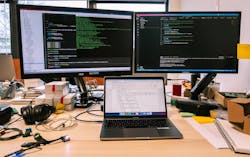What you’ll learn:
- What is a cyber-physical system and how do we define it?
- What are some of its uses/applications in transportation, energy, and manufacturing?
- How to join a worldwide community of developers to share experiences, ideas, projects, and new ways of developing.
Cyber-physical systems (CPS) are intelligent systems that integrate physical and computer components which exchange data with each other. This interaction between the physical and computational components enables the system to make decisions and operate autonomously. A cyber-physical system typically has a network of interacting elements with physical input and output.
The term "cyber-physical system" was coined by Dr. Helen Gill of the U.S. National Science Foundation in 2006. CPS has a long history that dates back to the beginning of cybernetics, which was defined as the science of control and communication between machines and humans.
There are two types of CPS: autonomous CPS and closed-loop human-machine systems. Autonomous CPS are systems that can make decisions and operating independently. However, at this point, CPS development is mostly in semi-autonomous systems. These systems operate independently only in pre-defined conditions, such as semi-autonomous drones.
There are many examples of CPS, such as smart grids, autonomous automobile systems, medical monitoring, industrial control systems, robotics systems, and automatic pilot avionics.
Ongoing advances in science and engineering improve the link between computational and physical elements using intelligent mechanisms, increasing the adaptability, autonomy, efficiency, functionality, reliability, safety, and usability of cyber-physical systems.
What are the Attributes of Cyber-Physical Systems?
CPS generally combine sensor networks with embedded computing to monitor and control the physical environment. Feedback loops allow this external stimulus to self-activate communication, control, or computing.
These systems generally have three attributes: communication, control, and computing. Such attributes are necessary for the system to make decisions and operate autonomously. Developers can use these attributes to create more efficient, safe, and reliable systems.
What is the Key Characteristic of Cyber-Physical Systems?
The most important attribute of cyber-physical systems is the integration of physical and computational components. This interaction between the physical and the computational components enables the system to make decisions and operate autonomously.
When we talk about CPS, we can see the complexity of different interconnecting systems by making them communicate together. Luos has developed an open-source solution to enable adaptive electronics design based on developer needs and hardware availability.
IoT and Cyber-Physical Systems
The Internet of Things (IoT) is a network of physical devices, vehicles, home appliances, and other items embedded with electronics, software, sensors, and connectivity, enabling these objects to connect and exchange data.
IoT is transforming how we live, work, and interact with the physical world. For instance, a connected thermostat can automatically adjust the temperature of your home based on your schedule and preferences, and a connected car can diagnose problems and alert the driver.
IoT is a key enabler of CPS, as it allows physical objects to be connected and share data. This data can then be processed and used to make decisions.
How Will CPS Develop in the Future?
The future development of cyber-physical systems will be driven by the continued development of the IoT.
In addition, the continued development of artificial intelligence (AI) and machine learning (ML) will enable CPS to become more intelligent and adaptive. By leveraging these technologies, CPS can learn from their environment and interactions with humans to make better decisions. To take a real-life example, an autonomous car equipped with AI and ML could learn to avoid traffic jams by observing the behavior of other drivers.
Other Real-Life Examples
- Smart grid: The smart grid is a CPS that manages the flow of electricity using digital technology. This helps improve the power grid's efficiency, reliability, and stability.
- Autonomous vehicles: Autonomous vehicles are equipped with sensors and computing power that allow them to process data and make decisions in real-time. As a result, they can navigate without human input.
- Industrial control systems: These systems are used to operate and monitor industrial processes such as manufacturing, power generation, and distribution.
In manufacturing, CPS is used to control and monitor industrial processes and machines. This helps to improve the manufacturing process's efficiency and quality.
Cyber-Physical Security
As cyber-physical systems become more prevalent, it’s important to know the potential security risks.
Cyber-physical systems are often connected to the internet, making them vulnerable to cyberattacks. In addition, as these systems become more intelligent and adaptive, they could be manipulated by attackers to behave in unexpected ways.
It’s important to note that these security risks aren’t unique to CPS, but they apply to any system that combines physical and computational components. To avoid this, developers need to design CPS with security in mind from the beginning. They also should ensure that these systems are properly tested and monitored to detect and mitigate potential security risks.
Why are We Talking More About Cyber-Physical Systems?
Cyber-physical systems are receiving increased attention due to the many benefits they offer. In addition, the development of the Internet of Things IoT provides key enabling technology for CPS, as it allows physical objects to be connected and share data. Furthermore, developers can more easily access data and create feedback loops that enable the system to make decisions and operate autonomously.
Mixing CPS with a microservices philosophy and open-source Luos allows you to rethink the way you develop your code and project. In the embedded domain, gaining agility would allow projects of all types to be developed faster, with less difficulty and stress to maintain.
Thanks to these new approaches, many developers share projects and new ideas to speed them up. Luos has created a community of developers in the field of edge and embedded to exchange projects, issues, and ideas. A Discord has been opened to exchange with thousands of developers worldwide. We welcome anyone interested to join this worldwide community.

